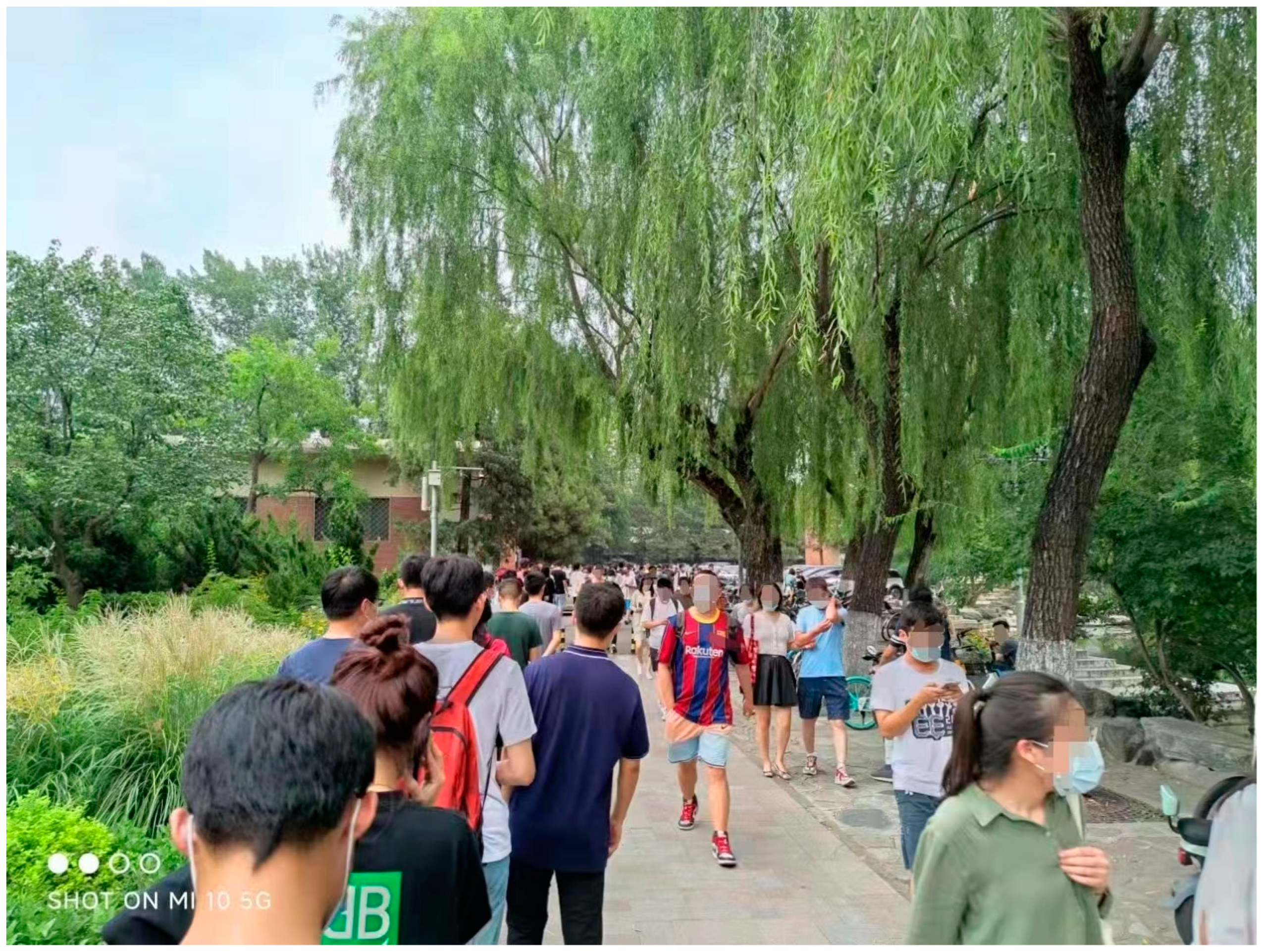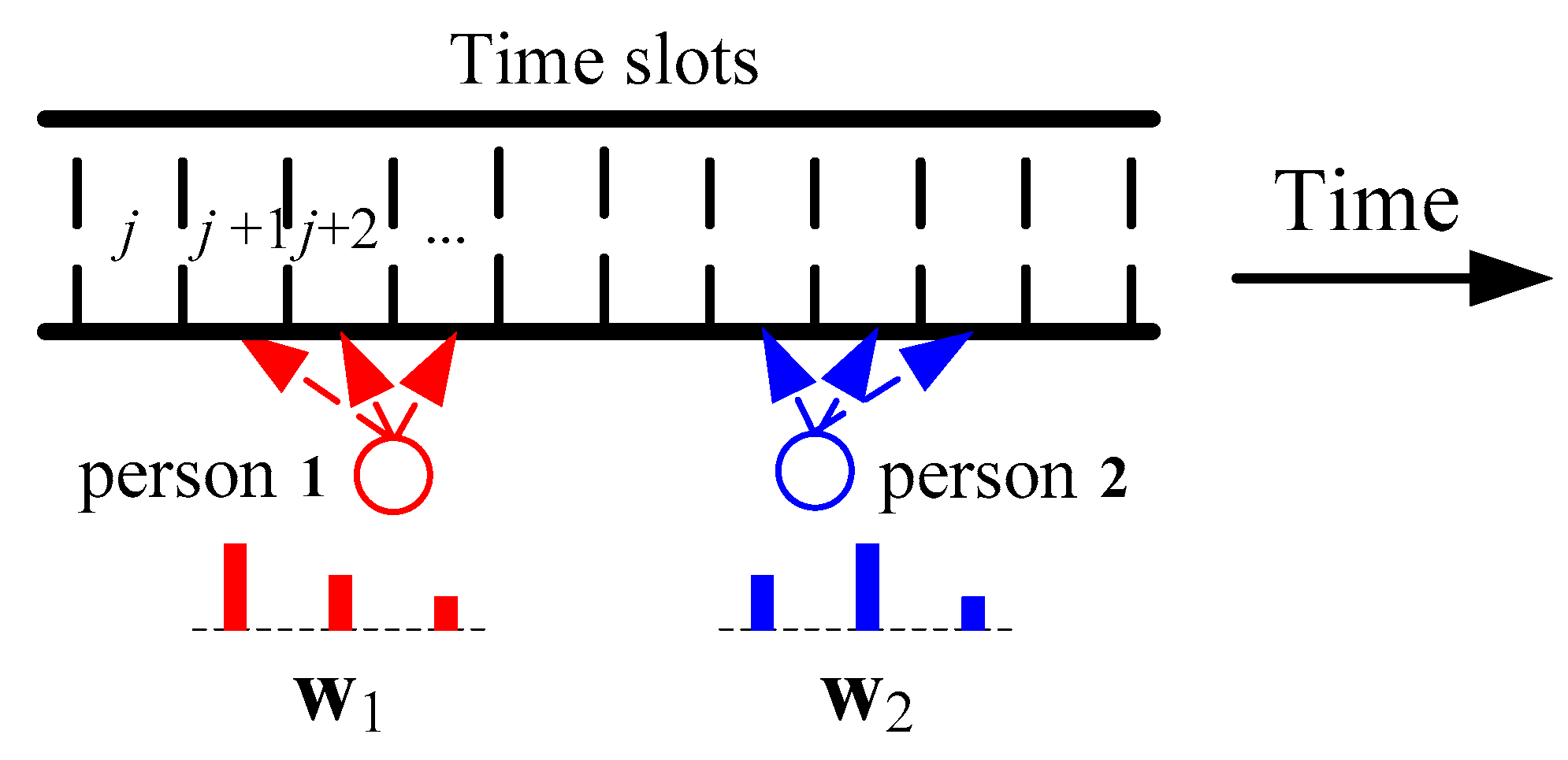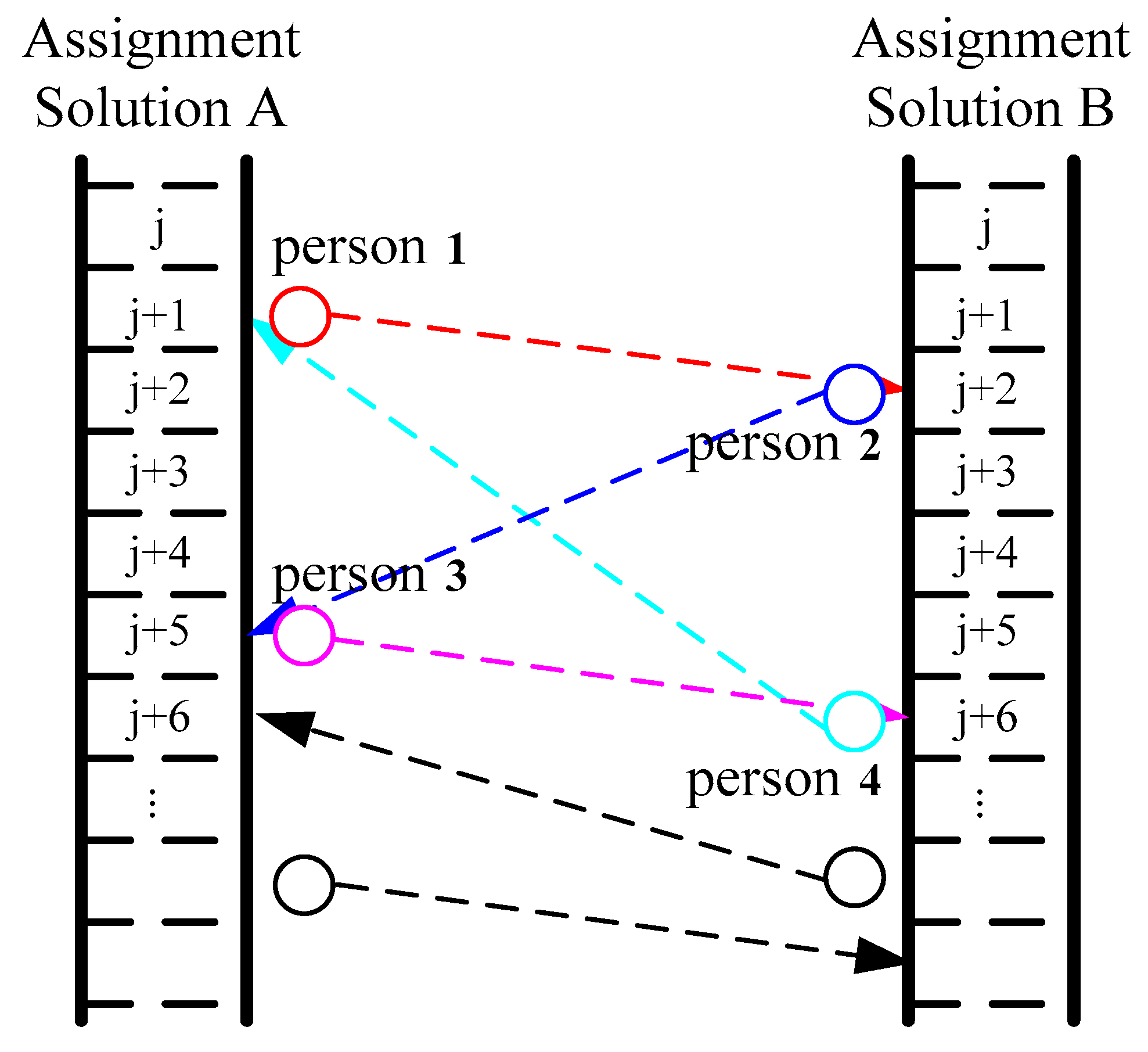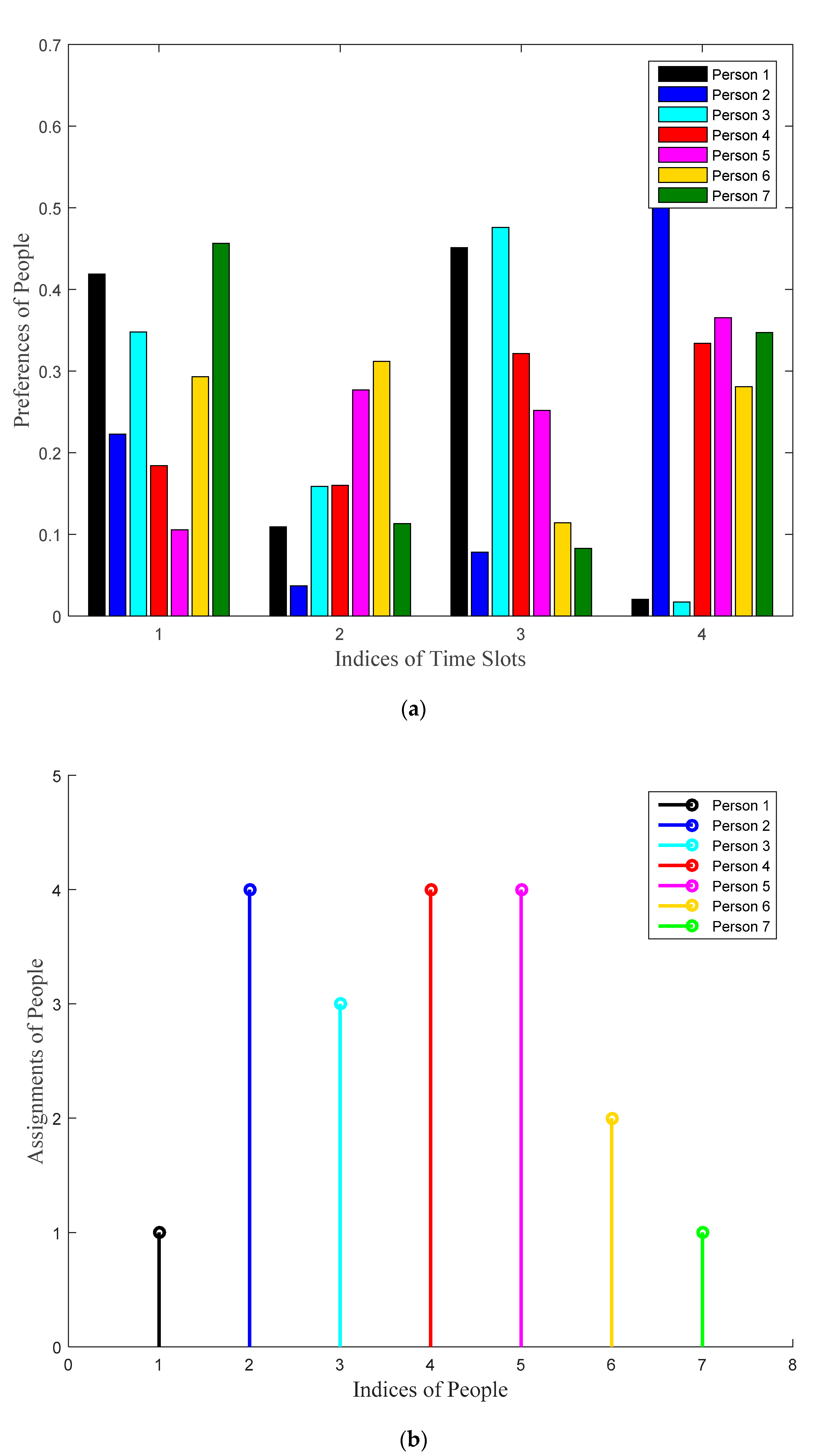Fair Assignment for Reserved Nucleic Acid Testing
Abstract
:1. Introduction
2. The Fair Assignment Problem
2.1. The Basic Problem and the Solving Method
2.2. Envy-Freeness and Minimum Total Envy
2.3. Improve Pairwise Fairness between People
| Algorithm 1: Shuffle Algorithm for Pairwise Fairness |
| Step 0: Suppose we have obtained the optimal assignment solution, and all people are sorted according to their indices. Set . Step 1: Start from person . Sequentially scan each of the th to the th remaining people to check whether we have an identical-but-unequally-treated people pair. Once we detect an identical-but-unequally-treated people pair, say person , it generates a random number uniformly distributed between 0 and 1. If this random number is larger than 50%, we exchange the time slots assigned to person and person ; otherwise, keep the current assignment. Go on until the rest of the people have been scanned. Step 2: Set . If , exit the algorithm; otherwise, go to Step 1 for another round of scan. |
3. Extensions and Discussions
3.1. Group Reservation Extensions
3.2. Multiple Nucleic Acid Testing Stations Extensions
3.3. Discussions of Fairness
4. Testing Results
5. Conclusions
Author Contributions
Funding
Institutional Review Board Statement
Informed Consent Statement
Data Availability Statement
Acknowledgments
Conflicts of Interest
References
- Benita, F. Human mobility behavior in COVID-19: A systematic literature review and bibliometric analysis. Sustain. Cities Soc. 2021, 70, 102916. [Google Scholar] [CrossRef] [PubMed]
- Au, W.Y.; Cheung, P.P.H. Diagnostic performances of common nucleic acid tests for SARS-CoV-2 in hospitals and clinics: A systematic review and meta-analysis. Lancet Microbe 2021, 2, e704–e714. [Google Scholar] [CrossRef]
- Esbin, M.N.; Whitney, O.N.; Chong, S.; Maurer, A.; Darzacq, X.; Tjian, R. Overcoming the bottleneck to widespread testing: A rapid review of nucleic acid testing approaches for COVID-19 detection. RNA 2020, 28, 771–783. [Google Scholar] [CrossRef] [PubMed]
- Zhang, S.; Su, X.; Wang, J.; Chen, M.; Li, C.; Li, T.; Ge, S.; Xia, N. Nucleic acid testing for coronavirus disease 2019: Demand, research progression, and perspective. Crit. Rev. Anal. Chem. 2022, 52, 413–424. [Google Scholar] [CrossRef] [PubMed]
- Wang, Y.-J.; Xue, J.-H.; Fang, Z.-X.; Xie, J.-W.; Niu, J.-J.; Yang, T.-C.; Lin, L.-R. A 14+7 day quarantine period and a dual nucleic acid testing reagent strategy detect potentially indiscoverable Coronavirus disease 2019 infections in Xiamen, China. Clin. Chim. Acta 2022, 532, 89–94. [Google Scholar] [CrossRef] [PubMed]
- Li, Z.; Gao, J. 15-Minute nucleic acid test circles strategy in large cities in China. J. Biosaf. Biosecurity 2022, 4, 84–85. [Google Scholar] [CrossRef]
- Foley, D.K. Resource Allocation and the Public Sector. Yale Econ. Essays 1967, 7, 45–98. [Google Scholar]
- Haddadi, S.; Gattal, E. Combining data reduction, MIP solver and iterated local search for generalized assignment. Int. J. Manag. Sci. Eng. Manag. 2022, 17, 93–102. [Google Scholar] [CrossRef]
- Öncan, T. A survey of the generalized assignment problem and its applications. INFOR Inf. Syst. Oper. Res. 2007, 45, 123–141. [Google Scholar] [CrossRef]
- Kuhn, H.W. The Hungarian method for the assignment problem. Nav. Res. Logist. Q. 1955, 2, 83–97. [Google Scholar] [CrossRef]
- Luenberger, D.G.; Ye, Y. Linear and Nonlinear Programming, 4th ed.; Springer: Berlin/Heidelberg, Germany, 2016. [Google Scholar]
- Aigner-Horev, E.; Segal-Halevi, E. Envy-free matchings in bipartite graphs and their applications to fair division. Inf. Sci. 2022, 587, 164–187. [Google Scholar] [CrossRef]
- Asratian, A.S.; Denley, T.M.; Häggkvist, R. Bipartite Graphs and Their Applications; Cambridge University Press: Cambridge, UK, 1998. [Google Scholar]
- Hoffman, A.J.; Kruskal, J.B. Integral boundary point of convex polyhedral. In Linear Inequalities and Related Systems; Chapter 13; Kuhn, H.W., Tucker, A.W., Eds.; Princeton University Press: Princeton, NJ, USA, 1956. [Google Scholar]
- Veinott, A.F., Jr.; Dantzig, G.B. Integral extreme points. SIAM Rev. 1968, 10, 371–372. [Google Scholar] [CrossRef]
- Fisher, R.A.; Yates, F. Statistical Tables for Biological, Agricultural and Medical Research, 3rd ed.; Oliver & Boyd: London, UK, 1938; pp. 26–27. [Google Scholar]
- Schreiber, E.L.; Korf, R.E.; Moffitt, M.D. Optimal multi-way number partitioning. J. ACM 2018, 65, 1–61. [Google Scholar] [CrossRef]
- Ahmed, Q.I.; Lu, H.; Ye, S. Urban transportation and equity: A case study of Beijing and Karachi. Transp. Res. Part A Policy Pract. 2008, 42, 125–139. [Google Scholar] [CrossRef]
- Litman, T. Evaluating transportation equity. World Transp. Policy Pract. 2002, 8, 50–65. [Google Scholar]
- Sanchez, T.W.; Stolz, R.; Ma, J.S. Moving to Equity: Addressing Inequitable Effects of Transportation Policies on Minorities; The Civil Rights Project at Harvard University: Cambridge, MA, USA, 2003. [Google Scholar]
- Brams, S.J.; Taylor, A.D. Fair Division: From Cake-Cutting to Dispute Resolution; Cambridge University Press: Cambridge, UK, 1996. [Google Scholar]
- Liang, X.J.; Guler, S.I.; Gayah, V.V. An equitable traffic signal control scheme at isolated signalized intersections using Connected Vehicle technology. Transp. Res. Part C Emerg. Technol. 2019, 110, 81–97. [Google Scholar] [CrossRef]
- Tian, Q.; Huang, H.-J.; Yang, H.; Gao, Z. Efficiency and equity of ramp control and capacity allocation mechanisms in a freeway corridor. Transp. Res. Part C Emerg. Technol. 2012, 20, 126–143. [Google Scholar] [CrossRef]
- Kotsialos, A.; Papageorgiou, M. Efficiency and equity properties of freeway network-wide ramp metering with AMOC. Transp. Res. Part C Emerg. Technol. 2004, 12, 401–420. [Google Scholar] [CrossRef]
- Yin, Y.; Liu, H.; Benour, H. A note on equity of ramp metering. In Proceedings of the IEEE Conference on Intelligent Transportation Systems; IEEE: Washington, DC, USA, 2004; pp. 497–502. [Google Scholar]
- Arrow, K.J. A Difficulty in the Concept of Social Welfare. J. Political Econ. 1950, 58, 328–346. [Google Scholar] [CrossRef]
- Arrow, K.J.; Sen, A.; Suzumura, K. (Eds.) Handbook of Social Choice and Welfare; Elsevier: Amsterdam, The Netherlands, 2002; Volume 1. [Google Scholar]
- Wilhelm, W.E. A Technical Review of Column Generation in Integer Programming. Optim. Eng. 2001, 2, 159–200. [Google Scholar] [CrossRef]
- Wolsey, L. Integer Programming, 2nd ed.; John Wiley & Sons: Hoboken, NJ, USA, 2020. [Google Scholar]
- Zeighami, V.; Soumis, F. Combining Benders’ decomposition and column generationfor integrated crew pairing and personalized crew assignment problems. Transp. Sci. 2019, 53, 1213–1499. [Google Scholar] [CrossRef]




Publisher’s Note: MDPI stays neutral with regard to jurisdictional claims in published maps and institutional affiliations. |
© 2022 by the authors. Licensee MDPI, Basel, Switzerland. This article is an open access article distributed under the terms and conditions of the Creative Commons Attribution (CC BY) license (https://creativecommons.org/licenses/by/4.0/).
Share and Cite
Xie, N.; Liu, Z.; Chen, X.; Li, S. Fair Assignment for Reserved Nucleic Acid Testing. Sustainability 2022, 14, 11752. https://doi.org/10.3390/su141811752
Xie N, Liu Z, Chen X, Li S. Fair Assignment for Reserved Nucleic Acid Testing. Sustainability. 2022; 14(18):11752. https://doi.org/10.3390/su141811752
Chicago/Turabian StyleXie, Na, Zhidong Liu, Xiqun (Michael) Chen, and Shen Li. 2022. "Fair Assignment for Reserved Nucleic Acid Testing" Sustainability 14, no. 18: 11752. https://doi.org/10.3390/su141811752
APA StyleXie, N., Liu, Z., Chen, X., & Li, S. (2022). Fair Assignment for Reserved Nucleic Acid Testing. Sustainability, 14(18), 11752. https://doi.org/10.3390/su141811752





